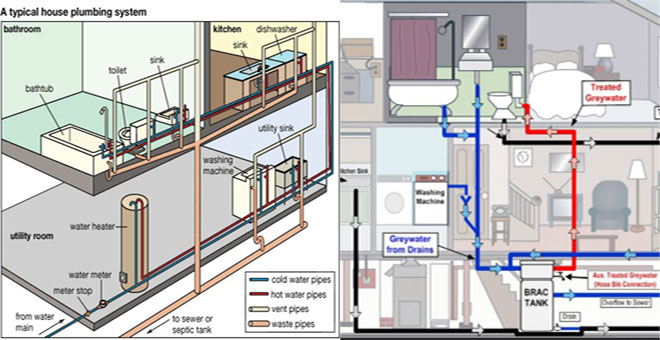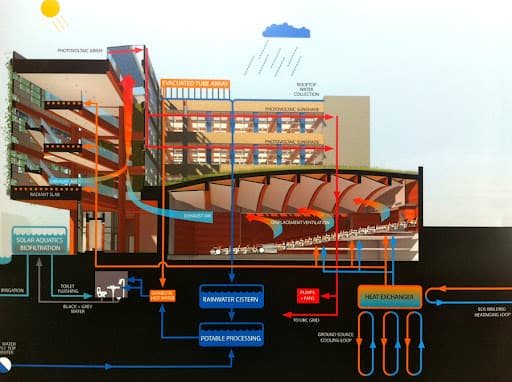Anatomy of Your House's Plumbing System: How It Matters
Anatomy of Your House's Plumbing System: How It Matters
Blog Article
Each person seems to have their own individual piece of advice when it comes to Understanding Your Home's Plumbing Anatomy.

Understanding exactly how your home's pipes system functions is crucial for every single property owner. From providing tidy water for drinking, food preparation, and bathing to securely eliminating wastewater, a properly maintained pipes system is important for your family's wellness and convenience. In this comprehensive overview, we'll explore the detailed network that composes your home's pipes and offer ideas on maintenance, upgrades, and taking care of usual problems.
Introduction
Your home's plumbing system is greater than just a network of pipes; it's a complex system that ensures you have accessibility to clean water and efficient wastewater elimination. Knowing its components and how they work together can aid you stop pricey repair work and guarantee everything runs smoothly.
Basic Components of a Pipes System
Pipelines and Tubes
At the heart of your plumbing system are the pipes and tubing that bring water throughout your home. These can be made from numerous products such as copper, PVC, or PEX, each with its benefits in regards to durability and cost-effectiveness.
Components: Sinks, Toilets, Showers, and so on.
Fixtures like sinks, bathrooms, showers, and tubs are where water is utilized in your home. Comprehending how these components attach to the pipes system aids in detecting troubles and intending upgrades.
Valves and Shut-off Points
Valves control the flow of water in your pipes system. Shut-off shutoffs are critical during emergencies or when you need to make repair work, allowing you to separate parts of the system without disrupting water circulation to the entire home.
Supply Of Water System
Main Water Line
The main water line connects your home to the municipal water or an exclusive well. It's where water enters your home and is distributed to various fixtures.
Water Meter and Stress Regulatory Authority
The water meter procedures your water usage, while a pressure regulator ensures that water moves at a risk-free pressure throughout your home's plumbing system, preventing damages to pipelines and fixtures.
Cold Water vs. Warm water Lines
Comprehending the distinction in between cold water lines, which supply water straight from the main, and warm water lines, which bring warmed water from the water heater, aids in fixing and preparing for upgrades.
Drain System
Drain Water Lines and Traps
Drain pipes bring wastewater far from sinks, showers, and toilets to the sewage system or septic tank. Traps protect against drain gases from entering your home and additionally trap particles that could create clogs.
Air flow Pipes
Ventilation pipelines allow air right into the drainage system, stopping suction that could slow down water drainage and cause catches to empty. Appropriate air flow is important for keeping the integrity of your plumbing system.
Relevance of Proper Drain
Ensuring appropriate water drainage prevents backups and water damages. Routinely cleaning up drains pipes and keeping traps can stop pricey fixings and extend the life of your plumbing system.
Water Heater
Sorts Of Water Heaters
Water heaters can be tankless or typical tank-style. Tankless heaters warm water as needed, while tanks store heated water for prompt usage.
How Water Heaters Connect to the Plumbing System
Recognizing just how water heaters connect to both the cold water supply and hot water circulation lines aids in detecting issues like inadequate hot water or leakages.
Upkeep Tips for Water Heaters
Regularly purging your hot water heater to remove sediment, inspecting the temperature setups, and checking for leakages can expand its lifespan and improve energy efficiency.
Typical Plumbing Problems
Leaks and Their Causes
Leakages can happen as a result of maturing pipelines, loosened fittings, or high water pressure. Attending to leaks quickly avoids water damage and mold growth.
Blockages and Blockages
Blockages in drains and bathrooms are typically triggered by purging non-flushable products or an accumulation of grease and hair. Utilizing drain screens and being mindful of what goes down your drains can prevent clogs.
Signs of Pipes Issues to Look For
Low water pressure, slow drains pipes, foul odors, or abnormally high water costs are indicators of potential plumbing troubles that need to be attended to immediately.
Pipes Upkeep Tips
Routine Assessments and Checks
Schedule yearly pipes assessments to catch concerns early. Try to find indications of leaks, corrosion, or mineral accumulation in faucets and showerheads.
DIY Upkeep Tasks
Basic tasks like cleaning tap aerators, looking for bathroom leaks making use of color tablets, or insulating revealed pipelines in cold climates can protect against major pipes problems.
When to Call a Professional Plumber
Know when a pipes issue calls for expert knowledge. Attempting intricate repair services without proper expertise can cause even more damages and higher fixing expenses.
Upgrading Your Pipes System
Reasons for Updating
Upgrading to water-efficient fixtures or changing old pipes can boost water high quality, reduce water costs, and enhance the worth of your home.
Modern Plumbing Technologies and Their Advantages
Check out technologies like clever leak detectors, water-saving commodes, and energy-efficient water heaters that can conserve money and lower environmental impact.
Expense Considerations and ROI
Determine the upfront expenses versus long-term cost savings when considering pipes upgrades. Many upgrades spend for themselves through minimized utility expenses and less repair services.
Environmental Effect and Conservation
Water-Saving Fixtures and Home Appliances
Installing low-flow taps, showerheads, and bathrooms can significantly decrease water use without compromising performance.
Tips for Lowering Water Usage
Straightforward routines like repairing leakages quickly, taking much shorter showers, and running full tons of washing and meals can preserve water and lower your energy expenses.
Eco-Friendly Plumbing Options
Think about sustainable pipes materials like bamboo for flooring, which is durable and green, or recycled glass for kitchen counters.
Emergency Readiness
Steps to Take Throughout a Plumbing Emergency situation
Know where your shut-off valves lie and how to switch off the supply of water in case of a ruptured pipe or significant leak.
Significance of Having Emergency Situation Contacts Useful
Maintain call details for local plumbings or emergency solutions readily available for quick action throughout a pipes crisis.
DIY Emergency Fixes (When Suitable).
Momentary solutions like making use of duct tape to patch a leaking pipe or putting a container under a trickling tap can decrease damages until a professional plumber arrives.
Conclusion.
Understanding the composition of your home's plumbing system empowers you to maintain it efficiently, conserving money and time on repairs. By following regular maintenance regimens and remaining educated about modern plumbing innovations, you can guarantee your pipes system runs efficiently for years to find.
HOW YOUR PLUMBING SYSTEM WORKS
Which Pipes Do What?
Blue lines = fresh water supply entering the building
Red lines = hot water supply entering the building
Grey lines = pipes carrying waste away from the building and venting pipes carrying gases away from the building (through the roof)
YOUR MAIN PLUMBING SYSTEMS
There are two main plumbing systems that support your home s basic plumbing needs one that brings clean water into your home, and one that sends dirty water away from your home. Connected to the toilet, bath, shower, and other faucets in your home, these two systems keep your water flowing in the right directions.
ACCESSING FRESH WATER
Fresh and clean water is brought into your home through the main water supply line . Filtered through one pipe, this water is pressured to flow into the various fixtures in your home at any given time.
This water can be sourced from a well located on your property, a pond or river (mostly cottages), or, as in most cases, from the city s municipal water treatment centre. However, it is important to note that water that is untreated, such as the water siphoned from ponds or rivers, may not be safe to drink. Personal water supplies always need to be treated for hardness and contaminants before consumed.
MUNICIPAL WATER SUPPLIES
Improve taste and odour
Remove sediment
Eliminate hardness
Reduce chlorine
COLD WATER SUPPLY VS. HOT WATER SUPPLY
Cold water flows into your home or building through the service line, which then distributes hot or cold water to your fixtures. This line is most commonly run through a central column that runs floor to floor. Hot water runs in short and straight pipes as the longer the pipeline, the more heat that will be lost in the transfer. Having shorter pipes also allows residents to access hot water more quickly.
WASTE WATER SYSTEM
Your wastewater system is divided into two parts pipes that send wastewater away from your home and venting pipes that send sewer gas away from your home. Sewage water travels through pipes that flush the water and waste towards local sewers that are operated and managed by your city or town. Most sewer systems rely on gravity to move the wastewater to where it needs to go.
The further away from your toilet or sink, the larger wastewater pipes become. This allows for waste to be disposed of from various parts of your home or business at once without pipe blockages. The angle and flow of these pipes are also essential for keeping your waste pipes clear of build up.
https://harrisplumbing.ca/how-your-home-plumbing-system-works/

HOW YOUR PLUMBING SYSTEM WORKS
Which Pipes Do What?
YOUR MAIN PLUMBING SYSTEMS
There are two main plumbing systems that support your home s basic plumbing needs one that brings clean water into your home, and one that sends dirty water away from your home. Connected to the toilet, bath, shower, and other faucets in your home, these two systems keep your water flowing in the right directions.
ACCESSING FRESH WATER
Fresh and clean water is brought into your home through the main water supply line . Filtered through one pipe, this water is pressured to flow into the various fixtures in your home at any given time.
This water can be sourced from a well located on your property, a pond or river (mostly cottages), or, as in most cases, from the city s municipal water treatment centre. However, it is important to note that water that is untreated, such as the water siphoned from ponds or rivers, may not be safe to drink. Personal water supplies always need to be treated for hardness and contaminants before consumed.
MUNICIPAL WATER SUPPLIES
COLD WATER SUPPLY VS. HOT WATER SUPPLY
Cold water flows into your home or building through the service line, which then distributes hot or cold water to your fixtures. This line is most commonly run through a central column that runs floor to floor. Hot water runs in short and straight pipes as the longer the pipeline, the more heat that will be lost in the transfer. Having shorter pipes also allows residents to access hot water more quickly.
WASTE WATER SYSTEM
Your wastewater system is divided into two parts pipes that send wastewater away from your home and venting pipes that send sewer gas away from your home. Sewage water travels through pipes that flush the water and waste towards local sewers that are operated and managed by your city or town. Most sewer systems rely on gravity to move the wastewater to where it needs to go.
The further away from your toilet or sink, the larger wastewater pipes become. This allows for waste to be disposed of from various parts of your home or business at once without pipe blockages. The angle and flow of these pipes are also essential for keeping your waste pipes clear of build up.
https://harrisplumbing.ca/how-your-home-plumbing-system-works/
As a person who reads on Anatomy of a House: Understanding the Components, I think sharing that piece of content was a great idea. Sharing is nice. Helping others is fun. Thanks a lot for taking the time to read it.
Estimating Report this page